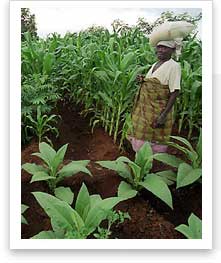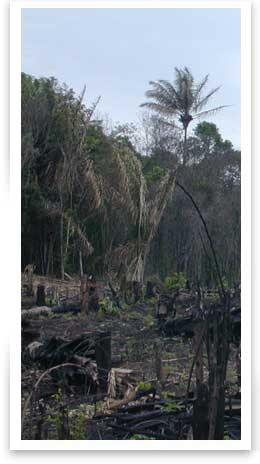Management of human interactions with tropical ecosystems: management of secondary drivers
Introduction
The management of human interactions with tropical savanna and rainforest ecosystems, primarily through the management of secondary drivers of degradation (as discussed above), is a huge topic in itself. A long list of natural resource management issues could be examined including; forestry, grazing, cropping, subsistence farming, weed invasion, game hunting, mining, fires, road building, tourism etc. In the following subsections we will use two central case studies to examine the two most widespread and potentially damaging interactions humans have with these ecosystems, forestry and agriculture.
Sustainable Forest Management
As discussed in the introduction to this course tropical rainforests and savanna ecosystems are being deforested, cleared and degraded at an alarming rate and it is essential that appropriate ways of managing these ecosystems for their products, provision of ecosystem services, and use for alternative activities are developed. At the forefront of forest management today is sustainable forest management (SFM), a sub-set of sustainable development that grew out of the concepts of sustainable forestry and sustainable yield.
The Food and Agriculture Organisation (FAO) defines sustainable forest management as:
- the stewardship and use of forests and forest lands in a way, and at a rate, that maintains their biodiversity, productivity, regeneration capacity, vitality and their potential to fulfill, now and in the future, relevant ecological, economic and social functions, at local, national, and global levels, and that does not cause damage to other ecosystems.
Criteria and indicators of sustainable forest management are important policy instruments used to implement progress which may be evaluated and reported on. Criteria define and characterise the essential elements, as well as a set of conditions or processes, by which sustainable forest management may be assessed, while indicators can be measured to reveal the direction of change with respect to each criteria.
Criteria and indicators of sustainable forest management are widely used and there are nine international and regional criteria and indicator initiatives involving more than 150 countries are in use (Castaneda et al. 2001). There is growing international consensus on the key elements of sustainable forest management and seven common thematic areas of SFM have emerged:
- Extent of forest resources,
- Biological diversity,
- Forest health and vitality,
- Productive functions and forest resources (i.e. ecosystem goods),
- Protective functions of forest resources (i.e. ecosystem services),
- Socio-economic functions (including many key ecosystem services), and
- Legal, policy and institutional framework.
Sustainable forest management is a concrete means of applying an ecosystem approach to forests and forest resources. Together these two concepts aim at promoting conservation and management practices which are environmentally, socially and economically sustainable both now and into the future.
![]()
Activity 4.7
Answer these questions based on the following readings:
- Pearce, D., Putz, F.E., Vanclay, J.K. (2003) “Sustainable Forestry in the Tropics: Panacea or Folly?” Forest Ecology and Management 172(2-3):229-247.
- Putz, F.E. (1994) “Approaches to Sustainable Forest Management” Working Paper N.o. 4 September, Center for International Forestry Research.
Q1 List and discuss as many harvesting and silviculture practices as you can identify in the above articles.
![]()
Include at least:
- Forest management harvest plans (refer to (Putz 1994) p2)
- Pre-felling vine cutting (refer to (Putz 1994) p2)
- Yarding i.e. process of extracting logs (refer to (Putz 1994) p3)
- Selective logging (refer to (Putz 1994) p.3)
- Properly constructed, located and utilized roads (refer to (Putz 1994) p3)
- Closure of logging area (refer to (Putz 1994) p3)
- Annual allowable cut (refer to (Putz 1994) p4)
- Growth monitoring (refer to (Putz 1994) p4)
- Controlled harvest (refer to (Putz 1994) p4)
- Post-logging silviculture treatments (refer to (Putz 1994) p4)
Q2 What type of timber harvest system has generally been more profitable to date? Discuss the factors that can be used to increase the use of sustainable forest management.
![]()
Conventional timber harvesting has been more profitable. Discuss at least the following factors which could increase the use of sustainable timber harvesting:
- Incentives
- Allowing for non-timber values
- biodiversity
- carbon
- Reduced environmental impact
- Certified timber
With reference to the relevant sections of (Pearce et al. 2003).
Q3 What are the three views presented on how forests can be used more wisely? Which do you believe to be most practical and effective? Refer to p4. (Pearce et al. 2003).
![]()
Three views presented:
- Conservation can be only achieved through outright protection
- Conservation can be achieved through an initial period of well managed logging followed by protection
- Conservation is best achieved through sustainable forest management
Q4 Discuss optimal forest use and the range of meanings this concept can have to different stakeholders.
![]()
A4 Answer with reference to (Pearce et al. 2003) p9.
![]()
Activity 4.8
Conduct internet searches on “sustainable forest management” and “forest ecosystem services” and take note of the amount of information and current projects focusing on sustainable forest management and ecosystem services.
Refer also to the following websites:
- International Institute for Environmental Development (IIED)
- International Tropical Timber Organisation (ITTO)
- Center for International Forestry Research (CIFOR)
- Forest Trends
Sustainable forest management and accounting for the ecosystem services provided by forests dominates research and development in the forestry industry. However it will take time and significant policy changes by governments as well as industry to achieve SFM globally.
A significant impediment to achieving sustainable forest management is illegal logging, which is the predominant means by which forests are logged throughout the topics.
Conduct an internet search on “tropical rainforests and illegal logging”. Refer also to:
- WWF and conduct a search on illegal logging
Based on the information you find discuss the extent of illegal logging in tropical regions?
The key threat to establishing sustainable management of tropical forests is whether illegal logging can be reduced and prevented while there are still significant areas of tropical rainforest left to manage sustainably.
![]()
The problem of illegal logging is extensive throughout topical regions with and average of 70-80% of logging activities conducted illegally. Examples of where illegal logging is occurring include Africa, the Amazon (89-90% logging illegal), Borneo, Sumatra, Indonesia (almost 70% of wood supply from illegal sources), Phillipines, Thailand (occurrence reduced due to ban on any logging of natural forests following devastating floods and landslides in 1989), Laos, Cameroon etc.
Managing Agricultural Activities
Managing agricultural activities in tropical rainforests and savanna ecosystems is a significant topic in itself. In this unit we are going to focus specifically on two case studies of agriculture in these ecosystems rather than the full range of effects and issues involved in managing agricultural activities in tropical ecosystems.
Agriculture Exploitation & Collapse: Failure to Understand Underlying Ecology
The agricultural endeavours of European settlers in Australia’s North provides a classic example of the consequences of failing to adequately understand the underlying ecology of ecosystems.
Activity 4.9
Read about the key features of agricultural failure in Australia's North with reference to examples.
- Woinarski, J.C.Z. & Dawson, F. (2001) “Limitless lands and limited knowledge: Coping with Uncertainty and Ignorance in Northern Australia.” In “Ecology, Uncertainty and Policy: Managing Ecosystems for Sustainability” Eds Handmer, J.W., Norton T.W., and Dovers S.R. Pearson Education, New York.
Slash-and-Burn & Sustainable Agriculture in Tropical Rainforests
The majority of farmers who live in the Brazilian Amazon are relatively recent settlers who have migrated from more temperate regions. The predominant form of agriculture used by these farmers is slash-and-burn agriculture, which involves the clearing and burning of plots of tropical rainforest to plant annual crops such as corn, rice and beans.
This form of agriculture is inappropriate for use on tropical rainforest soils as it strips the relatively infertile soils of nutrients, rendering the soil useless for agriculture in 3-5 years and often unable to be reinvaded by forest species (Caviglia and Kahn 2001).
Slash-and-burn agriculture is another example of an approach to agriculture that fails to adequately understand and accommodate the underlying ecology of the ecosystem.
Indigenous Amazonians and caboclos (settlers of mixed European and Indian descent who have been in the region for hundreds of years) use swidden agriculture, also known as shifting cultivation. This method of agriculture mimics natural disturbances facilitating sustainable use of the relatively infertile Amazonian soil. Small areas are cut and burned for agriculture, used for a few years and then left fallow. During the fallow the surrounding rainforest can quickly reinvade the disturbed area.
An evolving alternative approach to agriculture in tropical rainforest is the use of sustainable agriculture, which uses production techniques that maintain the nutrient cycle and allow for rapid recovery of cleared land. In this context sustainable agriculture involves the use of agroforestry (intercropping), harvesting of native fruits and nuts, fish harvesting, honey harvesting (Caviglia and Kahn 2001).
Agroforestry, also know as intercropping involves the clearing of small areas of land between trees, thereby maintaining much of the canopy cover, and the production of both annual crops such as corn and beans, as well as the nuts and fruits produced by perennial plants.
(Note this definition of agroforestry is specific to it’s use in tropical rainforest regions, particularly throughout the Amazon. In Australia agroforestry is more commonly used to refer to the incorporation of planted woodlots on agricultural land).
Activity 4.10
Answer with reference to the indicated pages in the following reading:
- Caviglia, J.L. and Kahn, J.R. (2001) “Diffusion of Sustainable Agriculture in the Brazilian Tropical Rain Forest: A Discrete Choice Analysis” Economic Development & Cultural change 49(2)311-333 (Refer to pages pp311-315, 328-329).
Q1 Describe the role of knowledge and property rights in determining the use of sustainable agriculture in Rondonia, Brazil.
![]()
When knowledge is provided farmers are more likely to adopt sustainable agricultural practices and exposure to knowledge is increased through membership in cooperatives. Other studies have found that secure tenure of land was the most important factor in the reduction of deforestation pressure on old growth forests in Bolivia. However, as property rights are well defined in Rondonia, (Caviglia and Kahn 2001) findings demonstrate that secure property rights alone are insufficient to insure sustainablility, although a necessary component.
Q2 What is the potential role of policy in increasing the adoption of sustainable agriculture in Rondonia, Brazil?
![]()
Information availability, education and participation in cooperatives can all be influenced by public policy. Therefore there is substantial potential for government policies to positively influence the adoption of sustainable agriculture.
Subsistence Use, Value, & Management of Savannas: The “Miombo Woodlands” of Africa
Miombo woodland is the most common southern hemisphere savanna ecosystem. The resources of these ecosystems are central to the livelihoods of millions of rural and urban dwellers (Campbell et al. 1996).
![]()
Activity 4.11
Answer these questions with reference to pp101-1135 of the following book chapter:
- Campbell, B., Frost, P., Byron, N. (1996) “Rural Households and Miombo Woodlands: Use, Value and Management” in “The Miombo in Transition: Woodlands and Welfare in Africa” Ed Campbell, B., Center for International Forestry Research, Bogor, Indonesia, pp175-193.
Q1 Discuss the range of products harvested from the Miombo Woodlands, their use, harvesting, availability and sustainability.
![]()
Discuss:
- Poles and construction materials,
- Firewood,
- Timber,
- Household implements and curios,
- Wildfoods (fruits, mushrooms, insects, leaves and roots, game, honey and beeswax),
- Medicines,
- Leaf litter,
- Browse,
- Tannins, dyes, oils, resins, gums,
- Service functions, and
- Spiritual and cultural values.
Q2 Discuss customary woodland management practices in Miombo woodlands and their interaction with other social, economic, and ecological determinants of resource management (e.g. local authority and state legislation, wealth and income etc).
![]()
Answer with reference to p125-135.
Topics in this module
- Introduction
- Management issues & drivers of degradation and deforestaton
- Ecosystem services and sustainable management of tropical ecosystems
- Application of the ESS concept for sustainable management of tropical ecosystems
- Management of human interactions with tropical ecosystems
- Compulsory readings




